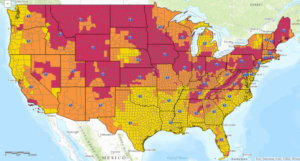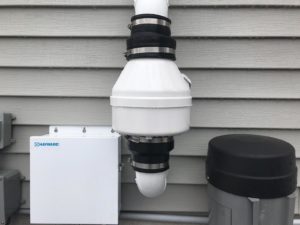- April 04, 2018
- 1 Comments
- In Occupant Health & Wellness Residential Home Performance
- By
National Public Health Week is this week and Today’s theme is “Environmental Health”, which includes protecting and maintaining a healthy indoor environment.
While National Radon Action Month was in January, we wanted to share how this specific indoor air pollutant can affect your health and what compelled a group of us here at SWA to get our homes tested (and remediated).
What is radon and why does it matter?
Radon gas is a naturally occurring byproduct of the radioactive decay of uranium found in some rock and soil. You can’t see, smell or taste radon, but it may be found in drinking water and indoor air. This carcinogenic gas is currently the second leading cause of lung cancer after smoking, according to the National Cancer Institute.
Although radon in drinking water is a concern, radon in soil under homes is the biggest source of radon, and presents the greatest risk to occupants. This pressure-driven mechanism occurs when radon escaping the soil encounters a negative pressure in the home relative to the soil. This pressure differential is caused by exhaust fans in kitchens, bathrooms and appliances, as well as rising warm air created by furnaces, ovens and stoves.
Radon levels can vary dramatically within a region, county, or city. However, the EPA recommends that all homes be tested, regardless of geographic location. To see what the average levels are in your area, check the EPA Radon Zones map.
What radon levels are accepted? Ideal?
The EPA recommends less than 4 picocuries per liter (pCi/L). If higher levels of radon are discovered during testing, a remediation system can be installed to ventilate the space or the foundation. The EPA recommended level is a practical standard intended to be achievable by most residences and is not based on medical data.
The World Health Organization states that while there is no safe level, reducing radon levels below 2 pCi/L would likely reduce deaths associated with radon by 50%.
What radon levels did we have at our homes?
I had been hearing one of our colleagues talk about radon for some time, but it wasn’t until she placed a canister on my desk and said “Test your house!” that I finally did it. And was I glad I did!! My results were off the charts! Over 60 pCi/L in the finished basement and 46 pCi/L on the first floor.
At these levels, I used my personal experience to encourage (scare) my colleagues into also taking the test. So far, the results have ranged from 1.5 to 5.2, but no one has beat my high score (phew)! I am currently having a sub-slab mitigation system installed (<$1,500), where holes will be drilled in my concrete slab and a fan will be installed outside that draws air from the slab and exhausts it outside. That way, whatever radon is in that slab, gets vented outside rather than up through my living space.
So, if you haven’t yet, you should test for radon ASAP!!
Various test kits are available, including short-term or long-term tests. Most short-term tests available to residents cost around $20-$40 and include the cost for the lab to process. You basically set up the test by leaving the canister or vial open for two to four days, then mail the test back to the laboratory for analysis. Here are a few tips for best results:
- Test in spaces that are below grade or at ground level.
- Test during different seasons, since radon levels can vary significantly throughout the year.
- Test again even if you tested when you bought your house, as levels can change. Fannie Mae recommends re-testing at least every five years.
For more information on radon and to learn about the tests kits available to homeowners, visit the EPA’s Radon Webpage.
By Gayathri Vijayakumar, Principal Mechanical Engineer




It really helped when you talked about radon and how it could be found in our water! Recently, my wife and I decided to start looking for our dream house, and after looking at some options, we think we found the one for us. We think it’d be smart to check our house’s state before moving into it, so we’ll be sure to add radon to our list. Thanks for the information on radon and how it could be dangerous to our health.